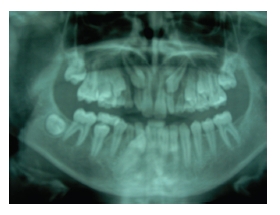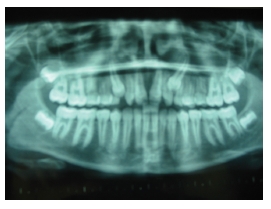Chapter 16
Ectopic canines
Normally, teeth erupt in sequence.
The permanent molars erupt distal to the deciduous dentition.
Incisors, canines and premolar teeth erupt into the space left by the exfoliated deciduous teeth.
An approximate guide to molar eruption is:
- first molars (the 6s) at 6 years
- second molars (the 7s) at 12 years
- third molars (the 8s) between 18 and 25 years (these are often referred to as wisdom teeth)
THE PROBLEM
Eruption is usually straightforward but occasionally a tooth fails to erupt because:
- the root of the baby tooth does not resorb and stays firm
- the permanent tooth is deflected and is late in eruption, or remains unerupted
- the required space is lost and either it stays unerupted, impacted or eruptsout of alignment
- the presence of a supernumerary tooth impedes the eruption of a permanent tooth, e.g. upper incisor
If a tooth remains unerupted and out of position, it is said to be ectopic, a specifically diagnostic term for a tooth following an incorrect path of eruption, which may be a reflection of abnormal crypt position or crowding.
This causes problems and the teeth which are most likely to fail to erupt because they are off course are the upper canines (Figure 16.1).
This is more common in females than males.
It is a condition that may have a hereditary factor (can run in families).
The upper canine begins its development high in the maxilla and has a longer distance to travel than any other tooth in the dentition, before it erupts.
More than three quarters of ectopic canines lie palatally to the dental arch.
Figure 16.1 Radiograph of ectopic canines.

By about 10 years, there is usually a bulge which can be palpated in the buccal sulcus to indicate that the tooth is on line. If it is not there, then the situation needs to be watched.
The dentist needs to monitor the progress of the tooth. In order to see just where it is and why it may not be erupting, radiograph(s) are taken. This also shows whether the crown of the permanent tooth is impacting into the roots of nearby incisors. This may cause them damage.
While this may be damaging, it is a painless process. Sometimes, the first sign that the ectopic tooth is in contact with and has severely damaged the root of a neighbouring tooth is that the tooth with the damaged root becomes loose. This can happen quite rapidly and may possibly result in the loss of this tooth. Because they are adjacent to the canines, the damaged tooth is often the lateral incisor. The orthodontist needs to know exactly where the unerupted tooth is lying in relation to the adjacent teeth.
It may be either:
- palatal (in the palate)
- labial (on the cheek side of the alveolus)
- across the dental arch (occasionally)
In order to find out the exact position, there is not always sufficient information provided by an orthopantogram alone. A periapical or lateral oblique occlusal of the area may also be needed to precisely locate the position and check on other possible anomalies.
If the canine (the 3) is not severely displaced then the extraction of the retained deciduous canine (the C) may often provide sufficient space to encourage its permanent successor to erupt.
However, these canine teeth sometimes:
- remain unerupted and buried in the maxilla
- erupt into the palate (infrequently)
Ectopic and/or unerupted canines are much rarer in the mandible than themaxilla.
Figure 16.2 Radiograph of bilateral upper ectopic canines in an older child

Treatment to retrieve these teeth can take many months and the patient has to be cooperative and understand that the treatment will take longer, especially if other features of the malocclusion have to be treated as well.
If a patient has not been referred in at the correct time (approximately 11 years old) and has a retained upper C (Figure 16.2) by the time they are in their mid-teens, they have a dilemma. They may have to:
- leave the baby tooth in situ and wait for it to finally fail
- have it extracted and replaced with a bridge or implant
- have it extracted and seek an orthodontic solution to retrieve the permanent tooth
An orthodontic solution may mean that the patient could still be wearing fixed braces long after their peers have had theirs remo/>
Stay updated, free dental videos. Join our Telegram channel

VIDEdental - Online dental courses


